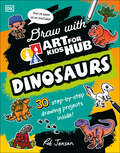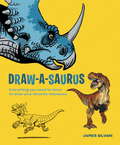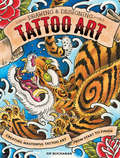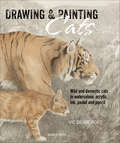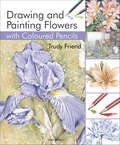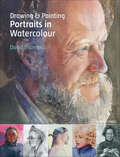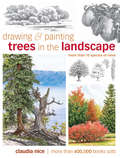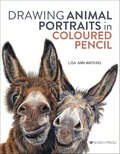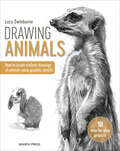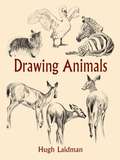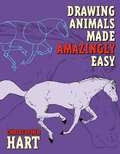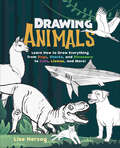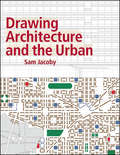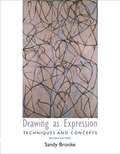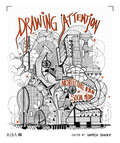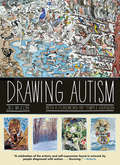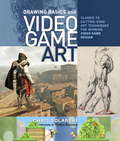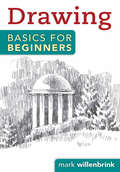- Table View
- List View
Draw the Line
by Laurent LinnAfter a hate crime occurs in his small Texas town, Adrian Piper must discover his own power, decide how to use it, and know where to draw the line in this stunning debut novel exquisitely illustrated by the author.Adrian Piper is used to blending into the background. He may be a talented artist, a sci-fi geek, and gay, but at his Texas high school those traits would only bring him the worst kind of attention. In fact, the only place he feels free to express himself is at his drawing table, crafting a secret world through his own Renaissance-art-inspired superhero, Graphite. But in real life, when a shocking hate crime flips his world upside down, Adrian must decide what kind of person he wants to be. Maybe it's time to not be so invisible after all--no matter how dangerous the risk.
Draw with Art for Kids Hub Animals
by Art for Kids Hub Rob JensenMillions of viewers have joined the fun and learned to draw with the YouTube sensation Art for Kids Hub. Now you and your whole family can too!Dad Rob and his family have built a huge following, thanks to their delightfully accessible lessons that gather the whole family to make art together. Their unique, easy-to-follow approach puts fun first, encouraging kids to draw in their own way and be proud of the results. Every idea inside—cute pets, jungle favorites, tiny critters, mythical creatures, and more—encourages you to have fun as a family and fall in love with drawing. By showing both the kid and adult versions of every animal, families can be creative together, and kids can discover the joy in simply drawing and avoid getting frustrated trying to recreate a perfect image.
Draw with Art for Kids Hub Cute and Funny Foods
by Art for Kids Hub Rob JensenMillions of viewers have joined the fun and learned to draw with the YouTube sensation Art for Kids Hub. Now you and your whole family can too!Dad Rob and his family have built a huge following, thanks to their delightfully accessible lessons that gather the whole family to make art together. Their unique, easy-to-follow approach puts fun first, encouraging kids to draw in their own way and be proud of the results. Every idea inside—from kawaii cakes to cute fruit, silly sushi and lunches that can talk—encourages you to have fun as a family and fall in love with drawing. By showing both the kid and adult versions of every food, families can be creative together, and kids can discover the joy in simply drawing and avoid getting frustrated trying to recreate a perfect image.
Draw with Art for Kids Hub Dinosaurs (Draw With Art For Kids Hub)
by Art for Kids Hub Rob JensenJoin the Art for Kids Hub family in their first-ever book series as they share super-fun, dinosaur-themed drawing activities.Draw with Art for Kids Hub: Dinosaurs brings the best of Art for Kids Hub to the printed page! Featuring popular hits from the channel, from adorable plant-eaters to cute and fearsome carnivores, kids and their families will be amazed at all the delightful dinosaur-themed characters they can draw. With these super clear and accessible step-by-step lessons, Dad Rob and family prove that anyone can learn to draw – and make it fun.Millions of YouTube viewers have learned to draw with the Art for Kids Hub. Now you and your whole family can, too!Step-by-step lessons that make the process super clear and super fun for everyoneA unique, accessible approach that prioritizes involvement over perfection. Kids are reassured that their efforts don't have to match the pictures to still look awesomeThe focus on family time encourages kids to draw with their grown-ups and share the enjoyment and satisfaction of making artEvery idea inside – including classic dino favorites such as the T. rex and Triceratops alongside fearsome flyers and underwater apex predators – encourages you to have fun as a family and fall in love with drawing. By showing both the kid and adult versions of every dinosaur-themed artwork, families can be creative together, and kids can discover the joy in simply drawing and avoid getting frustrated trying to recreate a perfect image.Art for Kids Hub has achieved over a billion views on YouTube by offering kids and families the perfect starting point on their drawing journeys. Dad Rob and his family have built a huge following thanks to their delightfully accessible lessons that gather the whole family to make art together. Their unique, easy-to-follow approach puts fun first, encouraging kids to draw in their own way and be proud of the results.Don’t miss the rest of the Draw with Art for Kids Hub series:Draw with Art for Kids Hub: AnimalsDraw with Art for Kids Hub: Cute and Funny FoodsDraw with Art for Kids Hub: ChristmasDraw with Art for Kids Hub: HalloweenDraw with Art for Kids Hub: Space
Draw with Art for Kids Hub Space (Draw With Art For Kids Hub)
by Art for Kids Hub Rob JensenJoin the Art for Kids Hub family in their first-ever book series as they share super-fun, space-themed drawing activities.Draw with Art for Kids Hub: Space brings the best of Art for Kids Hub to the printed page! Featuring popular hits from the channel, such as adorable planets and cute space pups, kids and their families will be amazed at all the delightful space-themed characters and objects they can draw. With these super clear and accessible step-by-step lessons, Dad Rob and family prove that anyone can learn to draw – and make it fun.Millions of YouTube viewers have learned to draw with the Art for Kids Hub. Now you and your whole family can, too!Step-by-step lessons that make the process super clear and super fun for everyoneA unique, accessible approach that prioritizes involvement over perfection. Kids are reassured that their efforts don't have to match the pictures to still look awesomeThe focus on family time encourages kids to draw with their grown-ups and share the enjoyment and satisfaction of making artEvery idea inside – from classic NASA-inspired rockets and space shuttles to intergalactic adventurers and out-of-this-world aliens – encourages you to have fun as a family and fall in love with drawing. By showing both the kid and adult versions of every space-themed artwork, families can be creative together, and kids can discover the joy in simply drawing and avoid getting frustrated trying to recreate a perfect image.Art for Kids Hub has achieved over a billion views on YouTube by offering kids and families the perfect starting point on their drawing journeys. Dad Rob and his family have built a huge following thanks to their delightfully accessible lessons that gather the whole family to make art together. Their unique, easy-to-follow approach puts fun first, encouraging kids to draw in their own way and be proud of the results.Don’t miss the rest of the Draw with Art for Kids Hub series:Draw with Art for Kids Hub: AnimalsDraw with Art for Kids Hub: Cute and Funny FoodsDraw with Art for Kids Hub: ChristmasDraw with Art for Kids Hub: Halloween
Draw-A-Saurus
by James SilvaniThis in-depth yet accessible dinosaur drawing guide combines humor, creativity, and the latest dino research to show artists young and old how to breathe life into drawings of their prehistoric favorites. Prehistoric Pencil Power! Even though they lived some 65 million years ago, dinosaurs and other prehistoric reptiles continue to rule today. From movies to comics and cartoons, these ancient, giant beasts are everywhere you turn. Of course, who wants to just read about or watch these dinos when you can learn how to use pencils, pens, markers, and more to draw your very own? Cartoonist James Silvani combines easy-to-follow art exercises with the latest, greatest dino-facts to help you create fun and cool dinosaur doodles all by yourself. With lessons on old favorites like T-rex and stegosaurus, as well as lesser-known (but still awesome) creatures like the massive argentinosaurus, Draw-a-Saurus has everything the dinosaur fan could ever ask for (outside of their very own pet dino!).From the Trade Paperback edition.
Drawing & Designing Tattoo Art: Creating Masterful Tattoo Art from Start to Finish
by Fip BuchananLearn how to create bold, original designs from a master tattoo artist!Tattooing is an art form like no other . . . indelible, wearable paintings, each on a one-of-a-kind, ever-moving "canvas." Step into the parlor with master tattoo artist Fip Buchanan as he shares more than thirty years of experience and the secrets to killer tattoo design. In these pages, you'll learn the practical considerations of placement, flow, and color choice, as well as the art of conceptualizing the kind of powerful, personal, out-of-the-ordinary designs worthy of being on a body for life. You'll even find inspiration for taking the look of tattoo art off -skin and into the realm of graphic design.Nine step-by-step demos reveal the author's creative process, from initial consultation and concept to finished tattooCovers popular subjects (snakes, dragons, portraits, hearts, roses and more) along with discussion of the symbolism behind themFeatures a chapter that explores tattoo styles applied to graphic artA gallery showcases the diverse styles of nine additional top tattoo artistsWhether you aspire to join the profession, are a graphic designer looking to expand your portfolio, or simply have a passion for tattoos, this book offers a rare inside look at the cutting-edge world of tattoo art.
Drawing & Painting Cats: Wild and Domestic Cats in Watercolour, Acrylic, Ink, Pastel and Pencil
by Vic Bearcroft* Multiple media makes it accessible to all artists. * Drawing titles are popular and cats are a perennial favourite. * Vic Bearcroft's previous book (Drawing and Painting Wild Animals) was very well-received and reviewed. This makes an obvious companion.
Drawing & Painting Flowers with Coloured Pencils
by Trudy Friend• A masterclass in all kinds of watercolour pencils • Complete course from first principles to your first masterpiece • Packed with dozens of examples and hundreds of invaluable guide notes
Drawing & Painting Portraits in Watercolour
by David ThomasPortraits are timeless and enthralling, and a discipline to which many artists aspire. Experienced artist David Thomas demonstrates how to use watercolour, pencil and charcoal to produce rewarding results in your portrait work. This book will show you how to fill your paintings with life and character, and explain clearly how to build your sketches up into more developed drawn artwork, and from there to inspiring watercolour portraits.Learn to use watercolour, pencil and charcoal to produce fresh and approachable portraits invested with life and character.
Drawing & Painting Trees in the Landscape
by Claudia NiceDraw & Paint Realistic Trees in All Four Seaons Bestselling author and naturalist Claudia Nice is back with another studio essential for every landscape artist. Drawing & Painting Trees in the Landscape features Claudia's best tips and techniques for painting trees of all kinds in their natural settings-from the majesty of mountain evergreens to the delicate pink blossoms of cherry trees in spring. With her inspiring artistic style and in-depth visual instruction, Claudia starts with the basics, showing you how to break down reference photos and open-air vistas into simple shapes, colors and textures. Follow along as she skillfully guides you through every step of creating vibrant compositions anchored by glorious trees and foliage, including: Drawing and sketching techniques for mapping out successful compositions A variety of basic tree shapes you can reference and copy; featuring more than 40 conifers, hardwoods and deciduous trees Proven color mixes for painting an array of vibrant hues-from the many different greens of foliage to the soft pastels of spring blossoms-using watercolor, oil, acrylics or mixed media Step-by-step instructions on drawing and painting important details, such as the weathered textures of bark, the sculptural shapes of bare branches in winter, aged mossy trunks and more Techniques for working smart in any medium, such as using simple watercolor washes for distant foliage, adding details with pen & ink, and "knife painting" in oils for interesting dimensional effects Whether your goal is to make accurate field sketches for your journal, paint what you see on your travels through the countryside, or just capture familiar views of your own back yard, Claudia makes the process fun, easy and satisfying. Like a walk in the woods, with every step you'll relax, enjoy and learn something new.
Drawing Animal Portraits in Coloured Pencil
by Lisa Ann WatkinsDraw realistic animal portraits in coloured pencils with award-winning teacher and animal artist, Lisa Ann Watkins.Animals are an eternally popular subject for artists but how do you capture the character of a much-loved pet or bring a favourite animal to life on the page? Lisa Ann Watkins has made a career of teaching her coloured pencil techniques, and in this magnificent book she will show you how.A section on materials covers coloured pencils and watercolour pencils, along with supporting tools including PanPastels. This is followed by a chapter about composition and preparation: how to capture the best reference photographs from which to work, along with notes on digital tools that can be used to help with colour choice and tonal values.Lisa's clear, simple techniques are presented through ten studies that demonstrate how to breathe life into your portraits by focusing on the subject's fur texture, bright eyes, and glossy noses.They answer, in simple terms, common technical questions from students/followers that cover unique aspects of the medium such as the amount of pressure to use—and make beautiful artworks in their own right. A series of five step-by-step full animal portrait projects then follows, ranging from cats and dogs to cows and horses.Project outlines and reference photos are available to download for free from Bookmarkedhub.com.
Drawing Animals
by Lucy SwinburneBrand-new, updated edition of the bestselling book, Drawing Masterclass: Animals by popular artist, Lucy Swinburne. Whether you want to capture a beloved pet cat or a magnificent wolf on paper, this book provides a complete course in how to draw them. All the essential drawing techniques and materials you need are explained clearly and simply by Lucy, and two brand new sections show you how to sketch the key features of a wide variety of animals such as eyes, ears and fur, and how to capture movement. The 20 step-by-step exercises inside draw on a diverse range of subjects from various continents, including meerkats, lizards and horses. This inspiring book is a must-have for any artist seeking to capture the spirit and character of animals in their drawings.
Drawing Animals
by Victor PerardA renowned artist/teacher expertly demonstrates the muted strokes, bold lines, and simple arcs needed to bring animal drawings to vivid life. Numerous sketches highlight these techniques for drawing more than 50 animals: bears, camels, deer, elk, lions, llamas, and others.Perfect for beginner or intermediate artists, this instruction book offers fascinating commentary that emphasizes animal anatomy and behavior. Its author and illustrator, Victor Perard, was a graduate of the École des Beaux-Arts in Paris and an art instructor at New York City's Cooper Union for twenty years. Perard's informative guide reflects his extensive teaching experience, providing practical advice for aspiring and experienced artists.
Drawing Animals (Dover Art Instruction)
by Hugh LaidmanA valuable guide by a well-known teacher and artist, this volume abounds in expert advice on methods and techniques for drawing animals, offering 26 lessons with step-by-step drawings of wild and domestic creatures. Author Hugh Laidman directed the U.S. Marine Corps art program, was commissioned by the National Gallery of Art to do work for NASA, and was a successful syndicated cartoonist. In Drawing Animals, his breadth of skill and experience has been successfully distilled into a concise, easy-to-follow and beautifully illustrated guide.Laidman offers knowledgeable advice on methods and techniques before proceeding to the heart of the book: expertly rendered instructional drawings of more than two dozen animals, from cats and dogs to elephants and gorillas. The emphasis throughout the text is on understanding animal anatomy and behavior as a guide to creating natural, expressive drawings, while developing an individual style and approach. Artists at all levels, beginner to expert, will find this book a source of inspiration as well as instruction.
Drawing Animals Made Amazingly Easy (Made Amazingly Easy Series)
by Christopher HartChristopher Hart, America's best-selling author of art instruction books, tosses all that aside to make drawing animals truly amazingly easy, by simplifying animal anatomy so that artists can get the poses they really want. What does that animal look like as it moves, bends, twists, jumps, runs? Simplified skeletons and an innovative new approach show how to look at an animal as a strangely built human with an odd posture--allowing the artist to draw animals by identifying with them. Hart's step-by-step instructions and clear text mean true-to-life results every time, whether the subjects are dogs, cats, horses, deer, lions, tigers, elephants, monkeys, bears, birds, pigs, goats, giraffes, or kangaroos.
Drawing Animals: Learn How to Draw Everything from Dogs, Sharks, and Dinosaurs to Cats, Llamas, and More! (How To Draw Bks.)
by Lise HerzogLearn how to draw cool creatures, awesome wildlife, and all your favorite animals with step-by-step instructions and helpful tips on the best drawing tools to try out.Follow along with your sketchbook, pens, and pencils as this easy-to-follow instructional book teaches you how to illustrate your favorite animals. With more than 150 step-by-step illustrations, Drawing Animals is the perfect guide for aspiring artists. Each chapter starts off simple, with how to draw basic animal body shapes. You will then learn how to adapt these bodies to create various species as you go along, including: Dolphins Horses Insects Birds Cats And even Dinosaurs! In addition to creating life-like animal illustrations, you&’ll also develop your technical drawing skills by learning which drawing tools will produce thin and thick lines, different levels of shading, and softer edges. Then you&’ll be able to use this knowledge to create the perfect finishing details for your animals, from scales to feathers to shaggy fur.
Drawing Anime Faces and Feelings: 800 facial expressions from joy to terror, anger, surprise, sadness and more
by Studio Hard DeluxeBig facial expressions are essential to anime and manga. They can be much more eloquent than printed words for getting an emotional response out of viewers. However, faces can be challenging. With this book, improve your anime-drawing skills with instruction for facial features and expressions for a wide variety of ages, character types, hair styles and activities. With 800 different facial expressions, you'll be able to draw your character in any emotional situation or with any reaction.
Drawing Architecture and the Urban
by Sam JacobyDrawing is an important means to analyse information and develop rigorous arguments both conceptually and visually. Going beyond the how-to drawing manual, this book provides an instrumental approach to drawing, especially computer-generated drawings; it outlines how drawings should be used to convey clear and analytical information in the process of design, as well as the communication and discussion of a project. In depth examples are provided how to communicate effectively. The final section demonstrates how to transform case-studies, directly connecting an analytical approach with the design process.
Drawing As Expression: Technique And Concepts (Second Edition)
by Sandy BrookeBenefiting all visual artists regardless of their level of expertise, this instructional guide to drawing covers all aspects of the craft–from basic skills and formal elements to introductory figure drawing and the advanced concepts of contemporary drawing–showing users how to combine their critical thinking skills with intuition and technical knowledge to create a visual language through drawing. Covers key drawing techniques, the function of drawing, and the concepts associated with good drawing. Offers a brief history of drawing, and follows with complete chapters on drawing media, the formal elements, line, value, perspective, color, texture, composition (space, plane & shape), cross-hatching and drapery, portrait, figure drawing, landscape. For all visual artists.
Drawing Atelier - The Figure: How to Draw in a Classical Style
by Jon DemartinArguably the most challenging of subjects for the artist, the human figure also offers opportunities for works of incredible beauty and complexity. In this book, one of today's leading figurative artists shares techniques and approaches for drawing the human form. With a reverent grounding in the methods of the Old Masters and keen perspective developed over Jon DeMartin's 20+ years of making and teaching art, this comprehensive workshop focuses on the power of line and how it can be used to achieve a convincing sense of dimension and life.Beautifully illustrated with classical drawings as well as step-by-step progressions, these lessons explore the enlightening practice of copying, how to use proportion and measurement wisely, drawing the head and its features, rendering the figure in motion, short-pose exercises, and much, much more. Throughout, artists will master techniques for achieving a compelling "living force" in their drawings, while building a base of understanding that will ultimately make the process more intuitive and enjoyable.
Drawing Attention: Architecture in the Age of Social Media
by Hamza ShaikhHow did you do that drawing? What software did you use? What’s your process? You may have found yourself asking these questions about a striking architectural drawing. In recent years, social media has become a primary source of expression for architects and designers, yet there isn’t always the means to find out how their works became reality. Giving you a peek behind the illustrative curtain, this book demystifies the process and technique that created some of the most outstanding drawings in your feed. Offering lessons that many universities don’t teach, it’s an essential guide for architecture students and designers, featuring profiles from highly regarded illustrators, thinkers, and emerging architectural influencers. Covering a mix of styles, concepts and mediums, it gives a detailed breakdown of a diverse range of drawing processes alongside technical tips and concept inspirations. Whether you’re a flourishing student or established professional: This is your guide to drawing attention.
Drawing Autism
by Jill MullinThis &“jaw-droppingly beautiful book&” explores the work and creative process of artists diagnosed with ASD, with a foreword by Temple Grandin (Library Journal). In this volume, behavior analyst and educator Jill Mullin has assembled a staggering array of work from established artists with autism like Gregory Blackstock and Jessica Park—as well as many who are unknown but no less talented. Their creations, coupled with artist interviews, comprise a fascinating and compelling book that serves to educate and inspire anyone who knows someone diagnosed with ASD. Mullin&’s introduction and the foreword by bestselling author Temple Grandin also provide an overview of autism, and advocate for nurturing the talents, artistic and otherwise, of autistic individuals. &“What is the actual experience of living with autism in a deep-felt sense, beyond the social stereotypes and headline-worthy superskills? Drawing Autism, a celebration of the artistry and self-expression found in artwork by people diagnosed with autism, explores just that. The stunning volume features works by more than fifty international contributors, from children to established artists, that illustrate the rich multiplicity of the condition.&” —The Atlantic &“Mullin . . . brings together fascinating works by 40 artists on the spectrum with their answers to her questions about their process.&” —The Boston Globe &“A testament to the power of art to reveal the inner world of people living with ASD.&” —Publishers Weekly
Drawing Basics and Video Game Art: Classic to Cutting-Edge Art Techniques for Winning Video Game Design
by Chris Solarski"This book supports my own 30-year crusade to demonstrate that games are an art form that undeniably rivals traditional arts. It gives detailed explanations of game art techniques and their importance, while also highlighting their dependence on artistic aspects of game design and programming." -- John Romero, co-founder of id Software and CEO of Loot Drop, Inc.Video games are not a revolution in art history, but an evolution. Whether the medium is paper or canvas--or a computer screen--the artist's challenge is to make something without depth seem like a window into a living, breathing world. Video game art is no different. Drawing Basics and Video Game Art is first to examine the connections between classical art and video games, enabling developers to create more expressive and varied emotional experiences in games. Artist game designer Chris Solarski gives readers a comprehensive introduction to basic and advanced drawing and design skills--light, value, color, anatomy, concept development--as well as detailed instruction for using these methods to design complex characters, worlds, and gameplay experiences. Artwork by the likes of Michelangelo, Titian, and Rubens are studied alongside AAA games like BioShock, Journey, the Mario series, and Portal 2, to demonstrate perpetual theories of depth, composition, movement, artistic anatomy, and expression. Although Drawing Basics and Video Game Art is primarily a practical reference for artists and designers working in the video games industry, it's equally accessible for those interested to learn about gaming's future, and potential as an artistic medium.Also available as an eBookFrom the Trade Paperback edition.
Drawing Basics for Beginners
by Mark WillenbrinkSharpen your skills with these lessons designed to help you recapture the delight you took in drawing as a child. The Willenbrinks take you through several different approaches to the same subject matter designed to help you discover the best approach--or combination of approaches--for you.



